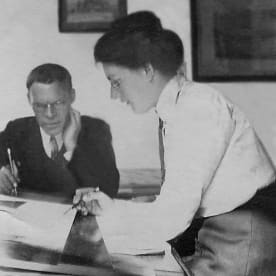

Lucy Greenish, photographed at work at her drawing board in an architectural office in Wellington in the 1910s. Sitting with her is architect William Page. (PHOTO: Stephanie Blatchford collection, Local History Room, Narromine Library, NSW)


Drapery shop in Wellington designed by Mary Taylor in 1849 (later was owned by James Smith, as it was when this photo was taken in c1886). (PHOTO: Credit, Wellington City Library.)


Lillian Chrystal sitting at her desk at 57 Symonds St (PHOTO: supplied by MUP)


The Auckland University College School of Architecture in 1943. The women students are all in the front row, with their teachers Vernon Brown and Cyril Knight at centre. From left: Wendy Whitlock, Muriel Lamb, Monica Ford (later Barham), Elizabeth (Libby) Taylor, Joan Maloney (school secretary), Vivienne Fenton (later Creagh), Helen Waddell, Renee McLaren and Mary Hay. Ed Lawry collection (PHOTO: Ed Lawry collection)


The Matapopore Trust and Ngāi Tūāhuriri were deeply involved in the development of Christchurch's new public library, Tūranga, with Architectus and Schimdt Hammer Lassen (2018). Adam Mørk (PHOTO: Adam Mørk)


Ngā Wai Hono at AUT's city campus, by Jasmax (2018). Jason Mann Photography (PHOTO: Jason Mann Photography)


A+W NZ / SGA Motu Kaikoura Workshop 2017 (PHOTO: Lynda Simmons)


A+W NZ Timeline (Hawkes Bay 2018) (PHOTO: Courtney Vuicakau)


book cover (PHOTO: Massey University Press)
We see their work, but do we know their names? The Kiwi women architects who have contributed to our built environment since the mid 1800s.
Wellington historian, Elizabeth Cox highlights the work of hundreds of women in her book Making Space: A history of New Zealand women in architecture.
30 architects, architectural historians, academics and students have collaborated on the finished work which contains more than 400 photos.
It tells a story of the barriers women have faced in an historically male dominated profession, and champions the work of women whose careers had not been documented.
Lynn talks to Elizabeth Cox and to architect and educator Lynda Simmons who has written two chapters.



















